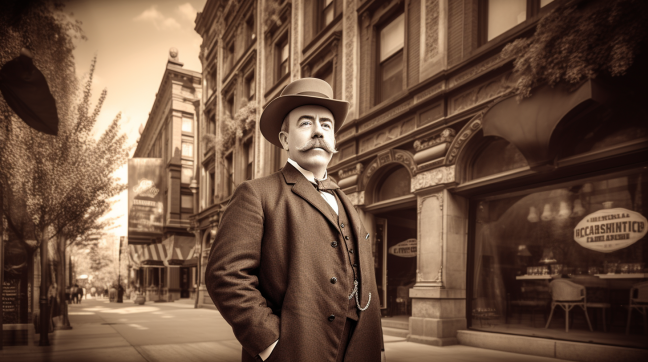Birth and Early Years: A Hazy Beginning
Born as Herman Webster Mudgett in 1861 in Gilmanton, New Hampshire, Holmes’ upbringing was reportedly abusive, filled with strict religious indoctrination. “The Devil in the White City” by Erik Larson dives deep into this troubled childhood, suggesting that this early phase might have served as a ‘criminal incubator.’
Education: The Art of Deception Begins
Holmes didn’t just attend the University of Michigan’s Medical School; he floated in and out of multiple institutions, using various aliases. Wendy Gamber, in her book “The Notorious Mrs. Clem,” delves into how Holmes used cadavers from his anatomy classes to make false insurance claims, beginning his career of scamming early.
Move to Chicago: The Stage is Set
When Holmes arrived in Chicago in the late 1880s, he worked at Elizabeth S. Holton’s drugstore in the Englewood neighborhood. Harold Schechter’s book “Depraved” cites witnesses who recall that after Holmes took over the business, the previous owners were said to have moved to California but were never heard from again.
The Murder Castle: A Diabolical Design
Built in Englewood, a suburb of Chicago, Holmes’ infamous “Murder Castle” was a labyrinthine structure with hidden rooms, gas jets for asphyxiation, and greased chutes to slide bodies to the basement. The basement itself contained vats of acid, quicklime, and a crematory. The Chicago Tribune’s sensational coverage at the time stated, “Every portion of the building was devised for murder.”
World’s Fair: A Hunting Ground
Holmes capitalized on the influx of visitors to the Chicago World’s Fair. He placed advertisements in small-town papers, promising employment or lodging. Vincent Bugliosi’s “Helter Skelter” claims Holmes seduced, swindled, and killed an estimated number of women ranging from 9 to 200 during this period.
The Crimes: Methodical Madness
Holmes’ modus operandi was chillingly methodical. He often rented rooms to victims, spied on them through peepholes, and controlled the environment with gas lines that led into their rooms. Jeff Mudgett’s investigations reveal that Holmes even had a dissection table in his basement where he stripped the flesh off his victims to sell their skeletons.
Capture and Trial: The End of the Road
Holmes was eventually captured and convicted for the murder of his business partner, Benjamin Pitezel, in a botched insurance fraud scheme. His subsequent trial became a media circus, with Clarence Darrow, the noted lawyer, describing the trial as “a showcase of human depravity.”
Execution and Postmortem: A Shrouded Death
Holmes’ peculiar request to have his coffin encased in cement has spawned multiple theories. Caleb Carr’s “The Alienist” discusses the possibility that Holmes feared body snatchers or maybe even retribution from beyond the grave.
Legacy: The Makings of a Myth
Holmes has transcended historical fact to become a kind of dark American myth. He’s inspired episodes of TV shows like “American Horror Story” and the board game “Killer Bunnies.” Ann Rule, the true crime writer, succinctly captures his lasting impact: “Holmes lingers in the public memory as the archetype of the urban predator.”
The Unfathomable Darkness of H.H. Holmes
H.H. Holmes was not just America’s first recorded serial killer; he was a symbol of the underbelly of the 19th-century American dream. His calculated machinations represent the horrors that can unfold when intelligence meets moral bankruptcy. With countless books, movies, and articles recounting his deeds, Holmes’ story continues to serve as a grim reminder of the potential for human evil.
